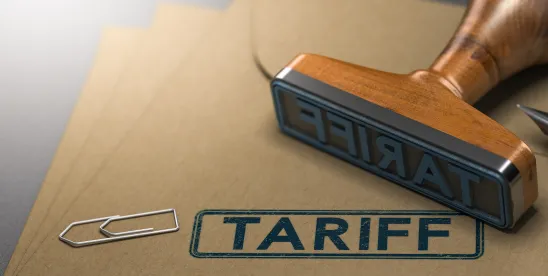UPDATE (as of Feb. 3, 2025, at 10:45 AM ET): President Trump announced on TruthSocial an agreement with President Claudia Sheinbaum of Mexico to “immediately pause the anticipated tariffs for a one-month period during which we will have negotiations.” No similar such agreement has been announced with regard to Canada or China.
On February 1, 2025, President Trump utilized emergency powers to impose 25% tariffs on U.S. imports of goods from Mexico and most goods from Canada, and 10% tariffs on U.S. imports of goods from China and energy resources from Canada, effective Tuesday, February 4th.1 These tariffs are in addition to any other duties, fees or charges applicable to the imported products. Specific U.S. Harmonized Tariff Schedule classifications impacted will be identified in a forthcoming Federal Register notice, but no product exemptions are identified in the February 1st actions. In retaliation for these new actions, also on February 1st, Canadian Prime Minister Justin Trudeau and Mexican President Claudia Sheinbaum announced plans to implement retaliatory trade measures against U.S. exports to those countries.
The February 1st Executive Orders imposed an array of tariffs:
- 25% tariffs on all goods from Mexico.2
- 25% tariffs on all goods from Canada, except for “energy resources” from Canada. “Energy resources” will be subject to a 10% tariff. For purposes of these tariffs, “energy resources” from Canada are defined as: “crude oil, natural gas, lease condensates, natural gas liquids, refined petroleum products, uranium, coal, biofuels, geothermal heat, the kinetic movement of flowing water and critical minerals, as defined by 30 U.S.C. 1606 (a)(3).”3
- 10% tariffs on all goods from China.4
The tariffs are effective Tuesday, February 4, 2025, with respect to all goods entered for consumption or withdrawn from warehouse for consumption, on or after 12:01 AM Eastern Time. There is a limited exception for goods on the water or in the air at the time the tariffs were imposed: goods that were loaded onto a vessel at the port of loading or in transit on the final mode of transport for entry into the United States before 12:01 AM Eastern Time on February 1, 2025, will not be subject to the additional duties if the importer certifies as much to U.S. Customs and Border Protection (CBP) in accordance with forthcoming procedures.
Goods subject to these additional tariffs are ineligible for duty-free treatment under de minimis provisions (19 U.S.C. 1321), consistent with proposed regulations from U.S. Customs and Border Protection exempting other items subject to special duties from de minimis benefits. In addition, no drawback shall be available with respect to the duties imposed by these Orders. Goods subject to these tariffs that are admitted to a Foreign Trade Zone must be admitted in Privileged Foreign Status, as defined in 19 CFR 146.41.
U.S. import tariffs will be implemented through a Federal Register notice to be issued by DHS modifying the Harmonized Tariff Schedule of the United States (HTSUS) as needed “in order to effectuate this order consistent with law[.]”5 The forthcoming notice may identify narrow products or import classifications exempt from the actions, but the Executive Orders do not signal any products or sectors outside of the scope – nor do the Orders direct any agency to establish an exclusion process through which companies could request to be exempt.
The White House Fact Sheet accompanying President Trump’s Executive Orders focuses on the role of China, Canada and Mexico in “the sustained influx of illegal aliens and illicit opioids and other drugs”6 into the United States. The tariffs will remain in place until the President determines that sufficient action has been taken to alleviate the crisis. The Secretary of Homeland Security, in coordination with the Secretary of State, the Attorney General, the Assistant to the President for National Security Affairs and the Assistant to the President for Homeland Security, are tasked with monitoring the situation and informing the President when the governments of the subject countries have taken adequate steps to alleviate the public health crisis through cooperative enforcement actions.
The Executive Orders also reserve the ability of the President to “increase or expand in scope the duties imposed under [each] order” should the countries retaliate against the U.S. in response to this action through import duties on U.S. exports to those countries. Canada and Mexico are both poised to take countermeasures against the U.S. Prime Minister Trudeau announced that Canada would impose 25 percent tariffs on US $107 billion (C $125 billion) worth of U.S. goods, with a portion of those tariffs effective on February 4th, contemporaneous with the effective date of the U.S. tariffs, and the rest phasing in after a 21-day public comment period.7 The initial measures are expected to impact US $20 billion in exports of U.S. beer, wine and bourbon, fruits and fruit juices, vegetables, perfume, clothing, shoes, household appliances, furniture, sports equipment, lumber and plastics.8 A second wave on another US $85 billion of goods would include tariffs on cars and trucks, agricultural products, steel and aluminum and aerospace products.9 Non-tariff measures are also apparently being considered. President Sheinbaum also stated that Mexico would take retaliatory tariff and non-tariff measures.10 Although her statements did not include details, reporting suggests that Mexico’s government is considering “so-called carousel retaliation, which would periodically rotate the U.S. products subject to retaliatory tariffs.”11 China’s reaction was more muted. China’s Ministry of Commerce issued a statement that “the Chinese government would file a complaint with the World Trade Organization and take unspecified ‘corresponding countermeasures to firmly safeguard its own rights and interests.”12
We expect a rapidly changing trade and tariff environment during the duration of the Trump Administration.
[1] Imposing Duties to Address the Flow of Illicit Drugs across Our Northern Border, Exec. Order (Feb. 1, 2025) (“Canada EO”), available at https://www.whitehouse.gov/presidential-actions/2025/02/imposing-duties-to-address-the-flow-of-illicit-drugs-across-our-national-border/; Imposing Duties to Address the Situation at Our Southern Border, Exec. Order (Feb. 1, 2025) (“Mexico EO”), available at https://www.whitehouse.gov/presidential-actions/2025/02/imposing-duties-to-address-the-situation-at-our-southern-border/; Imposing Duties to Address the Synthetic Opioid Supply Chain in the People's Republic of China, Exec. Order (Feb. 1, 2025) (“China EO”), available at https://www.whitehouse.gov/presidential-actions/2025/02/imposing-duties-to-address-the-synthetic-opioid-supply-chain-in-the-peoples-republic-of-china/.
[2] See Mexico EO at Sec. 2(a).
[3] See Canada EO at Sec. 2(a)-(b).
[4] See China EO at Sec. 2(a).
[5] See Canada EO at Sec. 2(e); see also Mexico EO at Sec. 2(d); China EO at Sec. 2(d).
[6] The White House, Fact Sheet: President Donald J. Trump Imposes Tariffs on Imports from Canada, Mexico and China (Feb. 1, 2025), available at https://www.whitehouse.gov/fact-sheets/2025/02/fact-sheet-president-donald-j-trump-imposes-tariffs-on-imports-from-canada-mexico-and-china/.
[7] Department of Finance Canada: Government of Canada announces next steps in its response plan to unjustified U.S. tariffs (Feb. 2, 2025), available at https://www.canada.ca/en/department-finance/news/2025/02/government-of-canada-announces-next-steps-in-its-response-plan-to-unjustified-us-tariffs.html.
[8] Department of Finance Canada: List of products from the United States subject to 25 per cent tariffs effective February 4, 2025 (Feb. 2, 2025), available at https://www.canada.ca/en/department-finance/news/2025/02/list-of-products-from-the-united-states-subject-to-25-per-cent-tariffs-effective-february-4-2025.html.
[9] Department of Finance Canada: Canada's response to U.S. tariffs on Canadian goods (Feb. 2, 2025), available at https://www.canada.ca/en/department-finance/programs/international-trade-finance-policy/canadas-response-us-tariffs.html.
[10] President Claudia Sheinbaum Pardo (@Claudiashein), X (Feb. 1, 2025, 8:07 PM), available at https://x.com/claudiashein/status/1885857655094415528?s=46.
[11] Santiago Pérez, Vipal Monga and Anthony Harrup, Canada, Mexico Want America to Feel the Pain of Tariffs Too, The Wall Street Journal (Feb. 2, 2025), available at https://www.wsj.com/economy/trade/canada-mexico-want-america-to-feel-the-pain-of-tariffs-too-f8119ccd (subscription required).
[12] Zia Weise, China to Retaliate after Trump Fires First Salvo in Trade War, Politico (Feb. 2, 2025), available at https://www.politico.eu/article/china-vows-retaliation-after-donald-trump-likely-trade-war-tariffs-chinese-imports/ (quoting the statement of China’s Ministry of Commerce from the Ministry’s website, available at https://www.mofcom.gov.cn/xwfb/xwfyrth/art/2025/art_a4a4f6e20b034cc78d506731007f1c1f.html).





 />i
/>i
